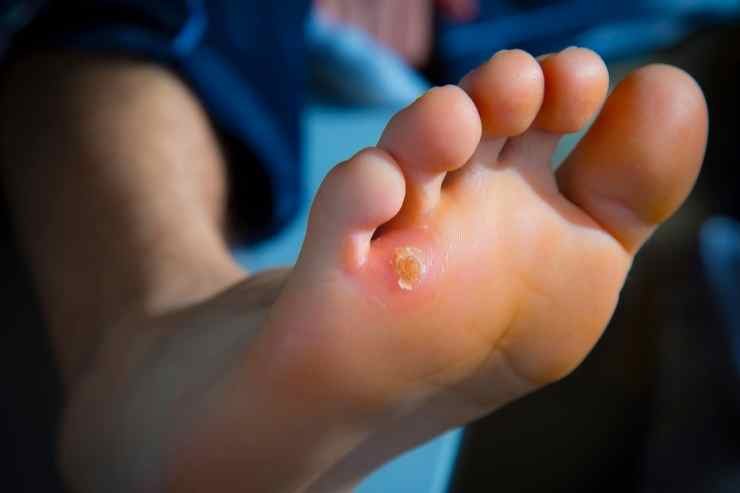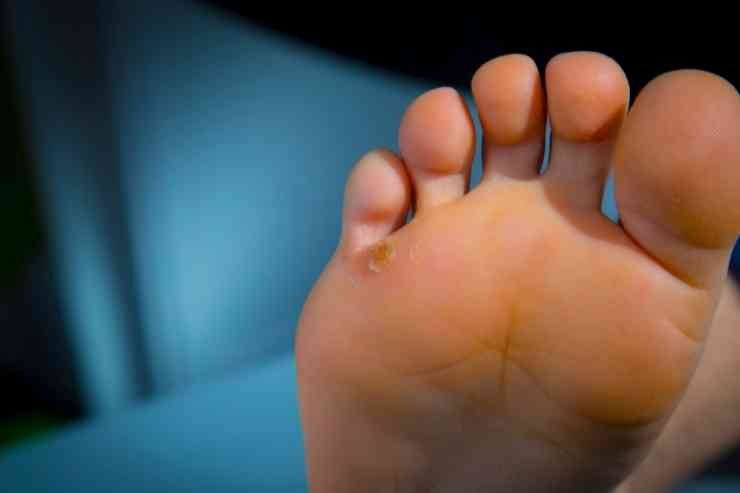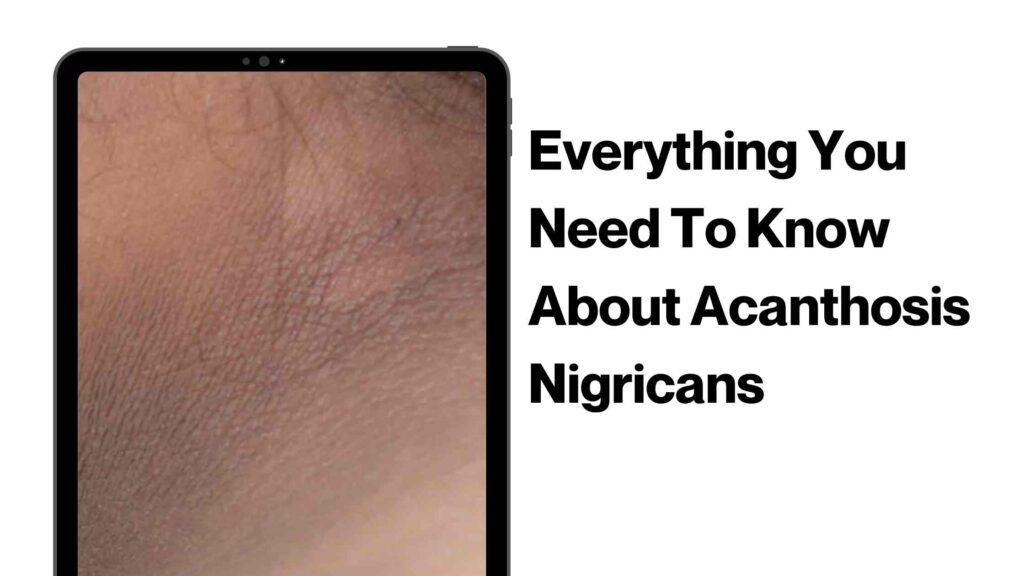Corns and calluses appear to be like thick and hardened layers of skin that develop when your skin tries to protect itself against recurring pressure or friction. The most common cause of corns and calluses is your shoes if they don’t fit properly. Hands and fingers are also the most common areas to form corns and calluses alongside your feet and toes. A healthy human being mainly does not require any treatment for corns and calluses unless they are painful or you don’t like their appearance. Sometimes, removing the source of the friction or pressure is all it needs to make your corns and calluses disappear.
This article will give you enough information about corns and calluses. So that if you ever happened to suffer from such a buildup of hardened skin, you know how to deal with them. Read on!

Read more about Keloid Scars- Symptoms, Treatments, Prevention
What Are Corns And Calluses?
As mentioned earlier, corns and calluses are a buildup of hardened and thick skin on different areas of your feet, toes, hands, and fingers. Although many people have experienced hardened skin areas on other parts of their bodies, the sites we mentioned lately are where you can usually see them.
Corns:
Corns are, in general, small in size and round in shape. And they are most likely to be seen on the tops or side of your toes. There are three types of corns you will come across, including:
- Hard corns: As the name indicates, hard corns are small in size and intricate and dense in appearance. They usually take a larger area and form where the bone pressurizes the skin. Hard corns typically appear on the top of toes.
- Soft corns: Soft corns are softer than hard corns and rubbery in texture. They are either whitish or gray in color and appear between the toes.
- Seed corns: If you happen to experience some small corns appearing on the bottom of your feet, undoubtedly, they are seed corns.

Calluses:
Corns and calluses are different by their appearance. But as compared to the corns, calluses are way larger and have more irregular shapes. However, calluses are also thick and hard patches of skin like corns. Calluses generally appear on the bottom of your foot, especially on the boney areas where your body puts optimum weight, such as your heel, the ball of your foot, your big toe, and the side of your foot. Though it is pervasive to notice some degree of callus formation on the bottom of your foot.
Some people often see calluses on their hands. Calluses often form where your skin experiences repeated friction or rubbing, such as on the tips of your fingers for playing guitar and on your hands if you are a weightlifter, gymnast, or craftsman.
Read more about How Much Does Scar Removal Cost In India?
How Are Corns And Calluses Formed?
There is only one reason behind corns and callus formation: repeated friction, irritation, or rubbing on the skin. Also, when there is excessive pressure on your skin, corns and calluses can appear. Corns and calluses typically appear on the prominent and boney areas of feet. When it comes to the hands, they are more likely to form where there is constant rubbing against the skin.
Corns and calluses are your body’s protective measures from the ongoing irritation and pressure.
Let’s Look At Some Common Causes For Corns And Callus Formation.
Ill-Fitting Socks Or Shoes:
When we wear tight shoes or high heels for which some areas of our feet get squeezed, corns and calluses can occur. Additionally, loose-fitted shoes that may repeatedly rub and slide against the skin of your feet may also get corns and calluses. Many people have experienced corns and callus formation because their socks don’t fit right.
Read more about How To Get Rid Of Milia Bumps?
Not Wearing Socks:
If you are someone who loves wearing shoes and sandals without socks, you can cause friction on your feet and end up having corns and calluses.
Standing Or Walking For A Long Time:
If your job includes standing, walking, or running for long periods, corns and calluses can generally appear on your feet.
Walking Heavily:
If you walk with improper posture, your foot’s inner or outer edge can develop corns and calluses.
Playing Guitar And Other Instruments Using Hand:
Corns and calluses on the hands generally occur due to the repeated pressure of playing guitar or other instruments and using other hand tools, even a pen.
Having A Tendency Of Developing Corns:
Many people experience a type of corn that forms on their non-weight-bearing areas, such as palms and soles. That might be caused by genetics.
Read more about How To Reduce Body Heat Pimples
Who Are More Likely To Get Corns And Calluses?
In general, corns and calluses appear due to repeated friction of the skin; you are more likely to develop them if you:
- Have one or more of the above causes of corns and calluses
- Smoke cigarettes
- Have a health condition that alters the normal alignment of the bones in your feet, for example, bunions, arthritis, hammertoes, etc.
How To Identify Corns And Calluses?
Corns and calluses generally have prevalent symptoms such as:
- Hardened skin where there is repeated friction or pressure
- Small, round, and hardened skin surrounded by irritated skin
- A flattened patch with thick and hardened skin
- Less sensitivity on the raised bump than the surrounding skin when touched
- Painful raised area causing discomfort
- Redness, blisters, and pain
How Your Doctor Diagnoses Corns And Calluses?
It is not difficult for a medical practitioner or doctor to diagnose corns and calluses. Your doctor might not suggest you any tests and still diagnose corns and calluses through a simple visual exam of the skin. Your doctor might ask you questions about your job, to know how much walking and standing you regularly do and what activities you participate in. If you have corns and calluses on your feet, your doctor might ask you to walk to check your posture and ask about your footwear.
What Are The Treatments Available For Corns And Calluses?
The simple way to stop the growth of corns and calluses is to avoid the repeated friction causing them to form. If you are wearing ill-fitted shoes, using some protective pads can help you. There are some treatment options available to treat corns and calluses, including:
Getting Rid Of The Excess Skin
Your health care provider can trim away the excess thickened skin with a scalpel. This procedure can be done during the first visit, but you must not try this yourself at home. Because by doing so, you might be prone to infection.
Trying Shoe Inserts
Suppose you have a record of underlying foot deformity. In that case, your doctor might prescribe you some custom-made padded shoe inserts to prevent corns or calluses from coming back.
Medicated Patches
Your doctor might apply a 40% salicylic acid patch to thin the thickened skin. You can also buy such patches without a prescription. But visiting a health care provider will help you know how often you must replace those patches. Your health care provider also might ask you to use a pumice stone or a nail file to thin the thickened skin before applying a patch.
Undergoing Surgery
Suppose the alignment of any bone is causing friction and leading to corns and calluses. In that case, your health care provider might suggest you undergo minor surgery. This type of surgery does not take much time and can be done without a hospital stay.
Home Remedies And Lifestyle Alteration To Treat Corns And Calluses
If you are diabetic or have other health conditions that cause poor blood flow, it is mandatory to consult with your health care provider before treating corn or callus on your own. However, if you don’t have any underlying health problems, you can try these suggestions to clear up a corn or callus:
- Soak Your Feet Or Hand In Warm Water: Soaking corns and calluses in warm and soapy water helps soften them. This will make it easier for you to remove the thickened skin.
- Use A Pumice Stone: You have already softened the affected skin after soaking your feet or hands in soapy and warm water. Now rub the corn or callus with a pumice stone or a nail file. That way, you can easily remove a layer of toughened skin of the corn or callus. Never use any sharp object to trim your skin. Also, avoid using a pumice stone if you are diabetic.
- Apply Moisturizer On Your Skin: Apply moisturizer on your hands and feet regularly to keep the corn or callus soft.
- Wear Comfortable Socks And Shoes: It is essential to buy and wear well-fitting and cushioned shoes and socks, at least when your feet have corn or callus.
- Use Foam Pads: You can quickly get donut-shaped foam pads available in the market to protect the area where the corn or callus has formed. If you are diabetic or have other health conditions causing poor blood flow, it is essential to avoid using such corn pads available over the counter. If you come across any nonprescription liquid corn removers, be careful while using them. Those liquids contain salicylic acid and can irritate your healthy skin and lead to infection.
- Trim Your Toenails: If you have long toenails, your toes can push against the top of your shoe and cause friction to your skin. And you already know that is how corns and calluses are formed. Therefore, it is essential to trim your toenails. Do not round the corners and cut your toenails straight across.
How To Prevent Corns And Calluses?
While we spend a lot of time and money taking care of other body parts, our feet are often overlooked. And that is how problems like corns and calluses occur. If you pay a little bit of attention and care to your feet, you can easily prevent most cases of corns or calluses. Remember these things as a preventive measure against corns and calluses:
Try Your Shoes Before Buying
It is essential to wear shoes that are comfortable and fit well. Therefore, while going shoe shopping, check whether your shoes provide enough support to your feet. Well-cushioned shoes and shock-absorbing soles are the best choices. The toe area of your shoes must have enough space so that your toes don’t rub against the shoe or other toes. This means that if you avoid narrow-toed shoes that cause your toes to rub against the shoe or each other, it can prevent the occurrence of corns and calluses.
Always Wear Socks With Your Footwear
Wear well-cushioned socks and your shoes, and also make sure that your socks don’t bunch up under your feet.
Wear Gloves During Laborious Work
If you are working with heavy and rough materials that can damage the skin on your hands or fingers, wear gloves.
Keep An Eye On Your Feet Daily
Inspecting your feet daily and keeping them clean can help prevent the chance of corns and calluses to some extent. Wash your feet in warm and soapy water every day and apply moisturizer after drying them. This will keep your skin soft and supple.
Some Frequently Asked Questions Answered About Cons And Calluses
Do Corns And Calluses Come Back After Healing?
Corns and calluses resulting from irritation, excessive pressure, and friction against your skin. Poorly fitted shoes are the most common cause of corns and calluses. Therefore, they can return at any point if the cause is not fixed.
Is There Any Over The Counter Medication To Treat Corns And Calluses?
Over-the-counter medications available to dissolve corns and calluses mainly contain harsh chemicals. Therefore, if you have little or no knowledge about applying such chemicals, it can injure the skin surrounding the corns and calluses. Additionally, if you are diabetic, self-treating may lead to infection.
Is It Important To See A Doctor When You Have Constant Calluses?
If you are diabetic, it is mandatory to see your doctor when you have corns and calluses. Diabetic people can lack sensation, making it difficult to detect pain sensations. Diabetic people also have poor blood circulation in their feet and legs, making a healing more difficult. Additionally, if you have any other underlying diseases, if your home treatment fails, or if you feel you have an abnormal bone structure that is causing corns and calluses, you need to see a doctor.
Conclusion:
You have gathered enough information about corns and calluses, and we hope you know what to do if you ever happen to have them on your skin. Corns and calluses are not life-threatening problems, and they can be reversed through simple care and medication. Keep this one suggestion in your mind- clean your feet regularly and invest in good pairs of shoes to keep yourself protected against corns and calluses. Keep following us to read many such informative articles about your health.
